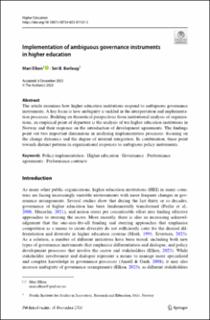| dc.contributor.author | Elken, Mari | |
| dc.contributor.author | Borlaug, Siri Brorstad | |
| dc.date.accessioned | 2024-02-12T12:19:17Z | |
| dc.date.available | 2024-02-12T12:19:17Z | |
| dc.date.created | 2024-01-02T11:17:01Z | |
| dc.date.issued | 2023 | |
| dc.identifier.issn | 0018-1560 | |
| dc.identifier.uri | https://hdl.handle.net/11250/3116980 | |
| dc.description.abstract | The article examines how higher education institutions respond to ambiguous governance instruments. A key focus is how ambiguity is tackled in the interpretation and implementation processes. Building on theoretical perspectives from institutional analysis of organisations, an empirical point of departure is the analysis of ten higher education institutions in Norway and their response on the introduction of development agreements. The findings point out two important dimensions in analysing implementation processes: focusing on the change dynamics and the degree of internal integration. In combination, these point towards distinct patterns in organisational responses to ambiguous policy instruments. | |
| dc.language.iso | eng | |
| dc.title | Implementation of ambiguous governance instruments in higher education | |
| dc.title.alternative | Implementation of ambiguous governance instruments in higher education | |
| dc.type | Peer reviewed | |
| dc.type | Journal article | |
| dc.description.version | publishedVersion | |
| dc.source.journal | Higher Education | |
| dc.identifier.doi | 10.1007/s10734-023-01161-2 | |
| dc.identifier.cristin | 2218763 | |
| cristin.ispublished | true | |
| cristin.fulltext | original | |
| cristin.qualitycode | 2 | |
